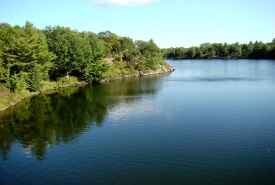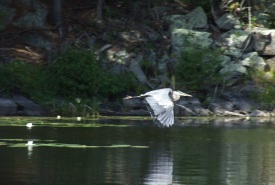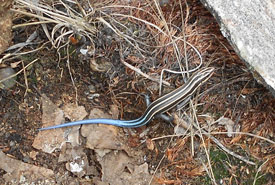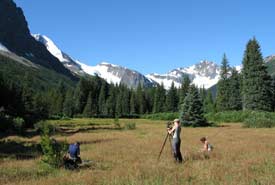A species' international highway

White-tailed deer (Photo by Lorne)
Humans aren’t the only creatures on Earth that need to get around. Animals in the wild have to travel as well, some to migrate, some to hunt and others to find mates. And that explains the importance of the Frontenac Arch, a 50-kilometre-long extension of exposed Precambrian rock that runs through southeastern Ontario and upstate New York, from Westport to the Thousand Islands.
This unique area of biogeographic overlap between the forests of the Canadian Shield and southern Carolinian sustains an incredible diversity of rare species, including the common musk turtle and the cerulean warbler. The Arch also serves as a natural link for wildlife travelling between the Adirondacks in the United States and the forests of the Algonquin Highlands in Canada.

Elbow Lake, Frontenac Arch, ON (Photo by NCC)
“It’s their international highway,” says Gary Bell, program director, Eastern Ontario for the Nature Conservancy of Canada (NCC). Bell has been working to better understand and protect this vital link.
Fragmentation poses the biggest threat to the Arch and its inhabitants. Roads, power line access trails, housing developments and other forms of development carve the forests into ever-smaller parcels, isolating and — in many cases — putting the species that use the area at risk.
In cooperation with partners like the Algonquin to Adirondacks Collaborative (A2A), NCC is identifying the best remaining big blocks of forest and working to keep them together so that animals can travel freely between them. “The idea is to make the connections between the pearls on the necklace as small as possible,” says Bell.

Great blue heron, Rock Lake, Frontenac Arch, Ontario (Photo by NCC)
The partnership with A2A has been crucial, he adds. While NCC has been focusing on the Frontenac Arch here in Canada, A2A has been doing similar work across the entire corridor, including in the United States, but on a much grander scale.

Five-lined skink, a species at risk in Ontario (Photo by NCC)
“They mapped everything that had been done on this in the past and studied the gaps in-between so that we now have a detailed understanding of the connectivity in the entire region,” says Bell. Once the pieces are identified, the NCC works to acquire the land parcels so they can remain in their natural state. “Most will be managed in perpetuity as nature reserves. Almost all are open to recreation, and many are open for hunting.”
Already, many species long thought lost are making a comeback, including the fisher, a medium-sized forest mammal. It and an extraordinary variety of salamanders, frogs and toads, snakes, and Ontario's only lizard, the five-lined skink, stand a better chance of survival if the forest highway remains open.
This post originally appeared in The Globe and Mail and was produced with the support of Randall Anthony Communications Inc.


